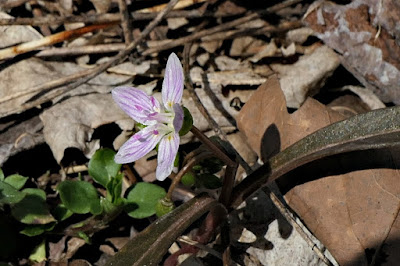On March 22nd Joan and I returned to Boch Hollow State Nature Preserve, an early springtime visit. Our last visit there had been in September, and it had been an even longer time since we started from the eastern trailhead.
For an even better look at skunk cabbage, check out the first part of this post.Just a few minutes away there were spring beauties on display.Joan and I stopped for our lunch under this rock formation.This would also be a great place to shelter from a rain squall. Just beyond, we peered down into a system of small ravines.Who keeps the top of this rock polished?Just a couple of minutes later, we heard a pair of owls calling to each other, exchanging what we dub "chimp hoots." I brought out my camera but caught only the last few calls, closer to the classic "Who cooks for you?" of the barred owl. We always find these birds exciting.
Then we descended into the next valley.Joan spotted a puttyroot orchid. It produces a single, white-veined leaf in the fall and stays green throughout the winter. The plant flowers in the spring as the leaf dies away.
We reached the pond that marks the beginning of the last leg down to the east parking area.We approached the pond cautiously to observe any egg masses, tadpoles, or small fish to which spring might have given a nudge. Tadpoles and small fish there were, but the highlight was several minutes spent tracking a red-spotted newt through our binoculars. Click on the image to enlarge.
Most salamanders do not become land dwellers until maturity, but this remarkable salamander does the opposite. Three or four months after hatching in the water it loses its gills, acquires lungs, and spends two to three years on land in the immature state, called a red eft for its bright red-orange skin. In the third year it changes from orange to olive green, returns to the water, and remains there as a mature red-spotted newt. Observing this fellow was definitely the highlight of our hike.
















No comments:
Post a Comment
Comments may not appear immediately as they are moderated by the author to eliminate spam. Please, no commercial links!